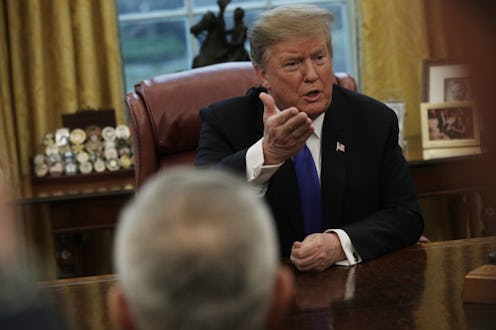News
What To Know About The Act Congress Could Use Against Trump's National Emergency

In mid-February, President Donald Trump declared a national emergency to build the southern border wall. Almost immediately Democratic politicians got to work to look for legal ways to oppose the president's move. One possible way to block Trump from using billions to build a border wall is a reform that came in the wake of the Watergate scandal. But what does The National Emergencies Act say? In addition to giving POTUS a great deal of power, it also places some limits on it.
The National Emergencies Act was signed into law by President Gerald Ford in 1976 as the country was rebuilding in light of Watergate. This law ended all previous national emergencies, while codifying the procedure for how presidents would proceed in the future when the need for a national emergency emerged. From the law's text, via the Legal Information Institute at the Cornell School of Law:
With respect to acts of Congress authorizing the exercise, during the period of a national emergency, of any special or extraordinary power, the President is authorized to declare such national emergency.
Although the law was passed to put checks and balances in place, according to Vox, it doesn't actually define "national emergency," meaning it could be applicable to many different situations.
As the Brennan Center for Justice explained, the law also "imposes procedural requirements on the President’s exercise of emergency powers." For example, every six months after the emergency has been declared, Congress must vote on whether the emergency needs to still be on the books. (The Brennan Center for Justice has a list of national emergencies declared since this legislation was enacted through 2018.)
On Feb. 15, Trump declared a national emergency on the southern border. "We're going to confront the national security crisis on our southern border, and we’re going to do it one way or the other," Trump told reporters in the White House Rose Garden, according to The New York Times. While the text of Trump's speech didn't explicitly mention the law, the president's comments make it seem like he still thinks it's on his side.
However, the National Emergencies Act actually allows Congress to undo a declaration of a national emergency, according to CNN. And the law has already been used to curtail one president's unilateral decision-making process. In 2005, according to USA Today, just the threat of the law being used caused then-President George W. Bush to back away from his decision to eliminate "wage laws on federal contracts to rebuild" the Gulf Coast that had been ravaged by Hurricane Katrina.
To that same end, according to The New York Times, House Speaker Nancy Pelosi has scheduled a vote on Tuesday to end Trump's national emergency declaration via the National Emergencies Act. The Times called the mechanisms of the National Emergencies Act "the simplest way" for Congress to block Trump's wall because it would only require a majority vote — at first. And such a resolution must be brought to the floor of the chamber within 18 calendar days, USA Today reported.
While the Democrats control the House, they will need a handful of Republican Senators to join them. This would lead to Trump's first veto as a president. In response, Pelosi and Democratic lawmakers would need to drum up two-thirds support for overturning the emergency declaration in order to make the congressional move veto proof, thereby killing Trump's emergency declaration.
"What's really important is how they will vote when it comes to the floor," Pelosi told The New York Times. "We'll see where they come down on that."